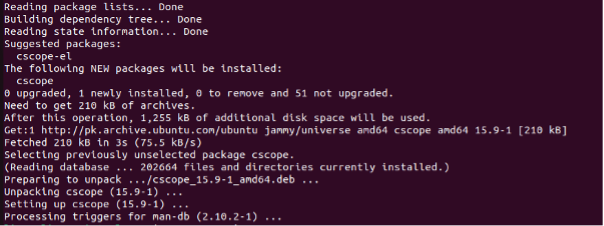What is a cscope Command in Linux?
Cscope is an old but interactive, efficient, and source-oriented tool available in the Linux operating system, which is used to browse C or C++ code to understand the structure of code by making function calls. It is a Linux command that interactively examines a C or C++ program. It can examine the source code files that are available in the current directory, i.e., C or C++ files with .c and .h extension, a lex file or .l extension, and a yacc source file with .y extension.
To locate a variable, function, macros, preprocessor symbols, and function calls, it uses cross-reference symbols called cscope.out by default. The symbol cross reference for the program that has to be browsed is built when the cscope command is invoked for the very first time on the source code file. For the subsequent mapping, the cross-reference will be rebuilt only if the source code file has been changed or if the source code file list changes. In the process of rebuilding the cross reference, the unchanged file’s data is copied from the old cross-reference to make the rebuilding process faster than the first build.
Why Do We Need the cscope Command in Linux?
It is quite easy to examine a few lines of code. But when we have a huge file containing hundreds or thousands of lines of code, it becomes difficult to find a particular function or line of code in that huge file. Or there are some situations where we find an open-source C or C++ application or system, and we want to make some contribution to it, so we start looking for the main function so that we can understand the code. We start making function calls one by one to get an idea of the function of the application.
In this whole process, we need to know some basic things, like what headers are included in the program and where they are exactly being used. Which function is called by which function and much more things? All of this cannot be done by skimming each line of code one by one. Here cscope comes in handy and helps the developers or coders to examine a file of code quickly and easily without investing much time or energy.
Install cscope in Linux Operating System Using apt-get Command
The cscope does not come along with the basic installation of the Linux operating system, so it needs to be installed separately. Assuming that you have a Ubuntu 22.04 system downloaded and installed and it is up and running properly. Now, start your ubuntu system and open the command line terminal to install the cscope package. Type the following command in your terminal and press enter to execute it:
As most Linux systems are password protected, so you need to provide the admin password to allow admin rights to install any library installed in the system:
Once you enter the password, the installation process will begin, and you will get the following output:
The cscope package is installed successfully; now, let us check the version of the cscope package by using the following command:
The –version flag is used to check the version of any package or library installed in the system. It is used with the commands to get the latest installed version. Here is the recently installed and updated version of cscope:
The cscope command in Linux comes with a variety of useful options that work perfectly with the cscope command. Each option works differently and offers different functions. The user can use any of the options available with the cscope command to get the work done. Now let us display the complete list of options available for the cscope command in Linux. For this matter, we will use –the help flag with the cscope command. See the statement below:
This will display the complete list of options for the cscope command with the description of each option. Have a look at the screenshot given below containing the list of options with their respective details:
This list is always available in the system; you just have to use the –help flag with the cscope command, and this list will be displayed. Whenever you forget any option or the function of any option, you can always refer back to this list and get to know the main function of the option. Now let us prepare the cscope database. The cscope command works with the database; it creates its own database and keeps the parsed source code in it. While searching for declarations, variables, header files, functions, etc., the database is used. To create the cscope database, four commands are used. The first command is used to change the directory:
The cd /home/linux/Downloads will change the current directory to the Downloads folder:
The next step is to switch to the root user. The “sudo su” command is used to change the switch to the root user:
The user is switched to the root user:
The next step is to find the name of the files to use as source files. Use the following command to do that:
This will look for all the available files in the current directory with .c, .cpp, .h, and .hpp extensions and store their paths to cscope.files file. The final step is to create the database of the file names available in the cscope.files file by creating three files named cscope.in, cscope.out, and cscope.in.out. The following command is used to create the database:
This will create the cscope database in the current directory.
Conclusion
In this manual, we demonstrated what the cscope command is in Linux and how it works. We explored how we can use it in Linux to completely understand its usage. The cscope command in Linux is used to examine or understand a C or C++ file quickly and easily. It is an old but efficient tool used to skim through the source code files.


